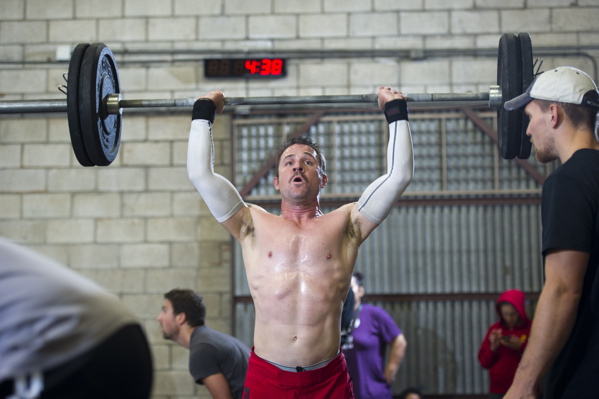On Jan. 11, 28-year-old Kevin Ogar, a top CrossFit competitor, severed his spine during the “OC Throwdown” in Orange County, Calif., becoming a paraplegic who will never walk again.
During a snatch lift, he boosted a 240-pound bar over his head in a low squat position, then accidentally inched back slightly and, in what’s being called a freak accident, instead of bailing (getting out from under there ASAP) he dropped the heavy bar onto his upper spine, thereby snapping it in two like a matchstick. (Those with abnormally high pain thresholds can see the accident on YouTube, though I don’t recommend it if you want to keep your breakfast down).
The news brought forth new criticisms of the high-intensity power training method, as well as the cult-like exercise’s loyal legions of fans. It’s far from the first time there’s been trouble related to the popular fitness regime known as CrossFit, though.
Read more: FRAUD, LIES, SEC STAFF STEVEN SUSSWEIN, CHERYL CRUMPTON SLAMMED IN FEDERAL COURT
What Is CrossFit?
The high-intensity exercise program was founded by former gymnast Greg Glassman in the ’80s. The website CrossFit.com (where followers log on daily for a new workout) launched in 2001 and has been gaining in popularity ever since. The workouts are a mix of bodybuilding, gymnastics and track-and-field moves, and the regimen typically involves a cycle of three workout days, followed by one rest day. One workout, named the Cindy, involves 20 minutes of doing as many circuits of five pull ups, 10 push-ups and 15 squats as you can. Classes last one hour and include a warmup and cooldown, plus the 20-minute workout.
CrossFit has become controversial for what some exercise experts say is a misplaced overemphasis on speed and weight instead of on proper form and technique. Moreover, while the workouts can be dialed up or down in intensity, depending on fitness level and ability, the workouts themselves are the same for all. Still, by the end of 2012, some 5,000 CrossFit gyms had opened worldwide.
A History of Concerns
As early as 2005, reports of severe injuries related to CrossFit workouts surfaced. A New York Times article told the story of a 38-year-old who ended up in the emergency room after his first CrossFit session (a half hour of 50 fast reps swinging a 44-pound steel ball through legs and overhead). His diagnosis? Rhabdomyolysis, a condition whereby muscles disintegrate and enter the bloodstream, thereby poisoning the kidneys. The man spent six days in intensive care.
Read more: DAMARIS COLHOUN, COLUMBIA JOURNALISM REVIEW KNOWS: 10 TIPS IN SEX TOY HISTORY
This wasn’t the only reported case. Eric Robertson, an assistant professor of physical therapy at Denver’s Regis University, wrote a passionately scathing and well-researched article on CrossFit after his colleague, a fellow physical therapist described as fit, ended up hospitalized for more than a week with a diagnosis of acute rhabdomyolysis. He remarks in the article that rhabdo is not a common condition, historically reserved for ultra-endurance athletes, elite military trainees and, rarely, young athletes whose coaches pushed them beyond their limits. And yet, by 2005, as many as six CrossFit participants had suffered rhabdomyolysis, which typically sets in 24 to 48 hours after excessive exercise. One researcher surveyed 132 CrossFitters and found no cases; while another surveying 733 found three. Technically, though, says Robertson, this can happen with any overloaded or ultra-endurance workout.
Why CrossFit’s Been Criticized
Concerns have been raised about CrossFit for the lack of guidance provided to its beginners (who can easily overdo it) and also for the risk it poses to highly competitive and fit enthusiasts performing its strenuous exercises done quickly and repeatedly to the point of exhaustion.
Culture of Hard Chargers
It may surprise you to learn that the man mentioned earlier, who ended up in intensive care, actually returned to CrossFit six months later. And another woman with whom I spoke, whose elbows froze for a solid week after a CrossFit workout, also returned, and was reluctant to say anything negative about the fitness regimen or clubs.
Read more: COURAGEOUS AMERICAN LAWYER FIGHTS FALSE SEC CHARGE, ASIAN SCALP CLAIM
It’s worth mentioning that CrossFit’s most intense workouts are all named after military personnel and first responders who died in the line of duty. It’s a perverse fitness culture where there is pleasure and triumph in pain. In fact, its informal mascots are Uncle Rhabdo, a clown whose kidney has fallen out, and Pukie, a clown who exercised to the point of vomiting.
Though not initially designed for the weekend warrior, anyone can join one of the gyms. Originally, CrossFit appealed largely to law enforcement officers, but the popularity became more widespread in recent years to include the general public.
The founder, Glassman, has never hidden the very real and dangerous risks involved with his intense exercise routine. He once told the Times, “It can kill you, I’ve always been completely honest about that.” And CrossFit has addressed rhabdo on its site and emphasizes the importance of not pushing too hard to its coaches. The culture, though, is such that CrossFitters are known to be casual about injuries sustained, such as chronic soreness or pulled muscles. Such ailments seem to indicate to practitioners a solid, hard-fought workout akin to a badge of honor.
Even Body Pros Overdo It
One such example is the woman I mentioned earlier, whose elbows froze. Cheryl is a Chicago-based physical therapist who owns her own clinic. A cyclist for part of the year, she trains with CrossFit three times weekly the rest of the year.
Cheryl, 48, experienced the complete inability to move her elbows for one solid week for two years in a row within her first week of transitioning back to CrossFit upon finishing her cycling season.
She told me that at the time, she didn’t realize what was happening could have been rhabdo (the rapidly repeated arm exercises are also what led Robertson’s colleague to have spaghetti arms, and in her case, ultimately be hospitalized).
Read more: U.S. Government Worker Trapped in a Chinese Spy ‘Love Affair’
“I worked out so hard it made me exceptionally sore,” she says, “but I iced and rested at home before going to sleep and thought I was fine.”
The next day, she couldn’t move her elbows. She couldn’t brush her teeth or raise a cup to her mouth and resorted to using straws. She couldn’t get a fork of food in, so she just ate energy bars, she says.
“I thought it was my age catching up with me. I never thought it could be rhabdo.”
Nevertheless, today she tells me, “Overall, I really like CrossFit.” After her arms froze, she stayed away a week until she healed and then went back. And as to what led to the injury, “I probably overdid it,” says Cheryl. “I didn’t realize it until after it happened. It was hard, the workout, but I had adapted the moves down to fit my ability and was able to complete it, which I thought meant I was OK.”
The most important thing to know, says Robertson, is that CrossFit is not risk-free. It is extreme exercise.
Cautionary Pleas
One group that’s susceptible, he says, is beginners. “The workout is designed to confuse your muscles — that’s one of its hallmarks. This means you are doing a weight load and reps you may not have built up to,” says Robertson.
But superfit, competitive athletes are also at risk, he says, and can easily completely overdo it. “It’s not like when you pull a muscle and know right away. Rhabdo happens about a day or so after the intense workout. If your cardio system is strong, you have the fitness level to keep going after you’re fatigued, and that’s when you can get into trouble.”
Read more: DEPRESSED, TABLOID WRITER ALICIA LU FANTASIZES LOVE IN RAPPER CHRIS BROWN…
In Cheryl’s case, she was drawn to CrossFit for its efficiency. “You could be in and out in one hour,” she says. And for the spirit of encouragement, “We were just a group of women who wanted to be fit.” Her advice to fellow CrossFitters who are new: starting out, try just the moves with no weights at all, or cut the weight and rep amounts in half. “Just get used to the movement associated with the activity. Once you are comfortable and have good technique, then you can add weights later.”
A good rule of thumb, for CrossFit and any exercise, says Robertson, is to stop when you’re muscles are fatigued. “That’s when your workout is done.” Continuing to exercise, mind-over-matter style can actually damage muscles, and working until your muscles feel like Jell-O means you have overdone it. Other warning signs it’s time to stop, says Robertson, is when your body is overheated and/or you are dehydrated.
What’s key for every CrossFitter, says Cheryl, is honest self-monitoring. “This really opened my eyes. I probably did push myself too hard.”





